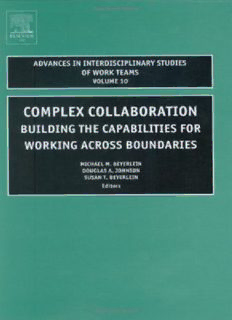
Complex Collaboration, Volume 10: Building the Capabilities for Working Across Boundaries (Advances in Interdisciplinary Studies of Work Teams) PDF
Preview Complex Collaboration, Volume 10: Building the Capabilities for Working Across Boundaries (Advances in Interdisciplinary Studies of Work Teams)
CONTENTS LISTOFCONTRIBUTORS vii ACKNOWLEDGMENTS ix ABOUTTHEEDITORS xi INTRODUCTION MichaelM.Beyerlein,DouglasA.Johnsonand SusanT.Beyerlein xiii DEVELOPINGCOMPLEXCOLLABORATIONS:BASIC PRINCIPLESTOGUIDEDESIGNANDIMPLEMENTATION DonMankin,SusanCohenandStephenP.Fitzgerald 1 CO-DEVELOPMENT:COLLABORATINGACROSS BOUNDARIESONJOINTSTRIKEFIGHTER JudeG.Olson 27 NOTYOURSTEPPINGSTONE:COLLABORATIONAND THEDYNAMICSOFFIRMEVOLUTIONINTHELIFE SCIENCES KennethW.KoputandWalterW.Powell 59 THEIMPACTOFCOLLABORATIVEMOTIVATIONON COMPLEXMULTI-AGENCYPARTNERSHIPS:ACASE STUDYOFTHEUNITEDKINGDOM JanineStilesandPaulWilliams 83 v vi COMPLEXCOLLABORATIONS:THECASEOFABUSINESS SCHOOLANDITSCOMPLEXNETWORKOF RELATIONSHIPS PeterLorange 109 INTEGRATINGPERSPECTIVES:AMULTIDIMENSIONAL CONSTRUCTOFCOLLABORATIVECAPABILITY MelanieSchreinerandDanielCorsten 125 THECOLLABORATIVECAPACITYFRAMEWORK:FROM LOCALTEAMSTOGLOBALALLIANCES StephenP.Fitzgerald 161 LEADINGCOMPLEXCOLLABORATIONINNETWORK ORGANIZATIONS:AMULTIDISCIPLINARYAPPROACH KarenL.HigginsandJosephA.Maciariello 203 “SKONKWORKSHERE”:ACTIVATINGNETWORKSOCIAL CAPITALINCOMPLEXCOLLABORATIONS LuAnneR.JohnsonandDavidKnoke 243 MANAGINGVALUEANDVULNERABILITYINCOMPLEX COLLABORATIONS:ALLYINGWITHCOMPETITORS JosephP.McGillandMichaelD.Santoro 263 LIST OF CONTRIBUTORS SusanCohen CenterforEffectiveOrganizations,University ofSouthernCalifornia,USA DanielCorsten KuhneInstituteforLogistics,UniversityofSt. Gallen,Switzerland StephenP.Fitzgerald CaliforniaSchoolofOrganizationalStudies, AlliantInternationalUniversity,Alhambra, CA,USA KarenL.Higgins ExecutiveDirectorandDirectorforResearch andEngineering,NAVAIRWeaponsDivision, ChinaLake,CA,USA LuAnneR.Johnson DepartmentofSociology,Universityof Minnesota,USA DavidKnoke DepartmentofSociology,Universityof Minnesota,USA KennethW.Koput EllerCollegeofBusiness,Universityof Arizona,USA PeterLorange IMD–InternationalInstituteforManagement Development,Lausanne,Switzerland JosephA.Maciariello DruckerGraduateSchoolofManagement, Claremont,CA,USA DonMankin Co:e-laborationDesignAssociates,Venice, CA,USA JosephP.McGill CollegeofBusiness,KeanUniversity,Union, NJ,USA JudeG.Olson LockheedMartinAeronauticsCompany, FortWorth,TX(AND)FieldingGraduate Institute,SantaBarbara,CA,USA vii viii LISTOFCONTRIBUTORS WalterW.Powell EducationandOrganizationalBehaviorand Sociology,StanfordUniversity,Stanford,CA, USA MichaelD.Santoro CollegeofBusiness&Economics,Lehigh University,Bethlehem,PA,USA MelanieSchreiner InstituteforTechnologyManagement, UniversityofSt.Gallen,Switzerland JanineStiles HenleyManagementCollege,Henleyon Thames,UK PaulWilliams NationalCentreforPublicPolicy,University ofWales,Swansea,UK ACKNOWLEDGMENTS ThisworkwaspartiallysupportedbytheCenterforCollaborativeOrganizations, formerlyTheCenterfortheStudyofWorkTeams.Thechangeinnamereflects our recognition that collaboration occurs at many levels of organization besides the team level. The Center has always considered bridging the gap between the academicandpracticeworldsamissiontobepursued.Thesuccessofthatbridging iscriticalforunderstandingpracticeandforbasingpracticeontestedtheory.The chaptersinthisbookreflectthiskindofbridgingpartnership. We want to acknowledge the help and support of Nancy Gorman. For four volumesinthisseries,Nancyhasbeenresponsibleforcommunicatingwithauthors, editors,andthepublisher,arrangingforflowofmanuscriptsbackandforthamong these people, educating all of us on manuscript format, arranging for proofing, catching the errors the editors miss and bringing the chapters, introduction, and prefacetogetherinafinalassemblytocompleteawholeforthepublisher.Nancy has done an outstanding job under significant time pressure to pull the pieces togetherintoacarefullypreparedmanuscript.Muchofthequalityinappearance forthisvolumeisduetoherthoughtfulwork. ix ABOUT THE EDITORS Michael Beyerlein is Director of the Center for Collaborative Organizations (www.workteams.unt.edu)andProfessorofIndustrial/OrganizationalPsychology at the University of North Texas. His research interests include all aspects of collaborative work systems, organization transformation, work stress, cre- ativity/innovation, knowledge management and the learning organization, and complexadaptivesystems.Hehaspublishedinanumberofresearchjournalsand hasbeenamemberoftheeditorialboardsforTEAMMagazine,TeamPerformance Management Journal, and Quality Management Journal. Currently, he is senior editoroftheElsevierannualseriesofbooksAdvancesinInterdisciplinaryStudies of Work Teams and the Jossey-Bass/Pfeiffer Collaborative Work Systems series. Hehasauthoredoredited15books.HismostrecentareBeyondTeams:Building theCollaborativeOrganization(2002),TheCollaborativeWorkSystemFieldbook (2003), and Team-based Organizing (2003). He has been involved in projects at theCenterforCollaborativeOrganizations(formerly,TheCenterfortheStudyof WorkTeams)withsuchcompaniesasBoeing,Shell,NCH,AMD,Raytheon,First American Financial, Westinghouse, and Xerox and with government agencies suchasVeteransAffairs,DCMAO,EPA,andtheCityofDenton. Douglas A. Johnson is director of the Industrial/Organizational psychology program, professor of psychology, and associate director of the Center for Collaborative Organizations at the University of North Texas. He has published researchinavarietyofareasrangingfromteams,leadershipandjobsatisfaction, tooperantconditioningandinterpersonalattraction.Heco-foundedandservedas presidentoftheDallas-FortWorthOrganizationalPsychologyGroup(nowDallas AreaIndustrial/OrganizationalPsychologists),andparticipatedinthecreationof the Dallas office of the consulting firm, Personnel Decisions International, from whomherecentlyretired. SusanTullBeyerleinholdsaPh.D.inorganizationtheoryandpolicywithaminor in education research from the University of North Texas. Since 1995, she has beenaninstructorofbusinessandpsychologyatOurLadyoftheLakeUniversity in Irving, Texas. Susan has served as a research scientist/project manager with theCenterforCollaborativeOrganizationsattheUniversityofNorthTexas,and has been a recipient of research grant awards from the Association for Quality xi xii ABOUTTHEEDITORS andParticipation,theNationalScienceFoundation,andcorporatedonors.Since 1995, she has co-edited the Elsevier/JAI Imprint annual book series entitled, AdvancesinInterdisciplinaryStudiesofWorkTeams,andhasservedasanadhoc reviewer for The Academy of Management Review. She has been a member of the Jossey-Bass/Pfeiffer Collaborative Works Systems series since its inception. SusanhaspublishedbookreviewsoncontemporarybusinessofferingsinBusiness andtheContemporaryWorld,andherworkhasalsoappearedinStructuralEqua- tionModeling:AMultidisciplinaryJournal,JournalofManagementEducation, EmpiricalStudiesoftheArts,andMultipleLinearRegressionViewpoints.Sheisa memberoftheAcademyofManagement,BetaGammaSigma–thehonorsociety forcollegiateschoolsofbusiness,andPhiKappaPhiNationalHonorSociety. INTRODUCTION Complex collaboration refers to situations where working together effectively acrossboundariesiscriticalforcomplexprojectsandproblems.Thisworkoften involves projects of large scope and long duration. The knowledge of a variety ofdisciplinesmaybeinvolved.Suchprojectsmaycrossorganizational,national, and/or cultural boundaries. The problem of managing such situations includes ambitiousschedules,conflictofculturesandpractices,massiveamountsofinfor- mation,multiplelanguages,andambiguityofrolesandresponsibilities.Complex collaboration represents a capability that is essential to effective execution in such situations as new product development, mergers and acquisitions, joint ventures,andsupplychainmanagement,aswellaslargegovernmentprojects.A numberofissuesemergeinexaminingcomplexcollaboration,including:unitof analysis,criticalrelationships,resourcedevelopment,virtualteaming,keyskills, andimprovementprocesses. The chapters in this volume address these issues and share examples that illustrate the principles that may be operating in complex systems. The authors suggestnewdirectionsforresearchwithsomearguingthatcomplexcollaboration maybeanemergingfield. (1) Is the unit of analysis for research and change work the same across levels of such complex systems or different? This issue deals with convergence of research and change work. Part of the question involves the practicality of attempting planned change in a complex system. Most successful change work focuses on limited systems. For example, what may be referred to as “workatthecorporatelevel”mayactuallybeassimpleasteambuildingwith the top management group. Interventions such as organizational redesign usually occur at single sites. Little literature exists to test the question of whetherornotchangeworkcanoccureffectivelyacrossmultipleboundaries. Ontheotherhand,researchersmustfindwaystostudythewholeofacomplex system,asmuchastheparts.Canaconvergenceofresearchandchangework improvethewaycomplexcollaborationcapabilityisdeveloped? (2) Doessuccessdependonafewcriticallinksorontheoverallsetofrelation- ships? A few critical members often determine how well an overall system functions.Thenetworkofrelationshipsacrosstheboundariesofcomponent systemsinacomplexcollaborationisoftenrepresentedbyhowthefewcritical xiii xiv INTRODUCTION membersinteract.However,totalperformanceofsuchasystemmaydepend more on raising the level of collaborative capability of all members. For example,ifafrontlineworkerincomponentsystemAcantalkdirectlywith a supply chain member in another component, an improvement in process may emerge. Is there an advantage in focusing on one or the other of these relationshipsets?Doesthepreferredfocuschangewithstageintheevolution oftheproject? (3) Shouldprojectleadersfocusresourcesoninfrastructureandskilldevelopment oronprocessimprovementtoachievehighperformance?Ineveryorganiza- tion,simpleorcomplex,resourcelimitationsmaketoughchoicesnecessary. Insituationswherecomplexcollaborativecapabilityisessentialtosuccessful attainment of organizational goals, the choice may be whether to spend resourcessuchasmoney,time,andpersonnelondevelopmentof:(a)infras- tructure surrounding the actual work, such as common computer platforms; (b) knowledge, skills, and abilities of the organizational members, so the qualityofcollaborationrisesatallpointsofcontact;or(c)processesthatguide decisions and behaviors toward effective collaboration. Perhaps the answer, asusual,is“itdepends.”Itmaydependonthenatureoftheproject,thestyle andphilosophyofthetopmanagementgroup,thelevelofcomplexityorun- certaintyorrisk,orthedifferencebetweencurrentlyadequateandinadequate levelsofsupport. (4) Can the teams rely on virtual communication or is face-to-face interaction necessary? Complex situations depending on collaboration for knowledge sharing,innovation,anddecisionmaking,ofteninvolvegeographicdistances that require use of electronic forms of communication, ranging from phone & fax, to email, to video conferencing. With heightened travel restrictions in most companies now, a heavier reliance on virtual communication has emerged. What is the role of face-to-face contact in this situation? When is that essential enough to warrant increased expense and risk? Is there a way tofindabalancepointbetweenthemethodsofmeeting? (5) Are the key skills lateral or hierarchical in making complex collaborations work?Crossingboundariesfornetworkingonaprojectinvolveslateralcom- municationsandtheskillsthatgowiththat,suchasthewhen,who,andhow ofconnection.Muchoftheinnovationworkoccursintheconversationsthat occurintheselateralrelationships.However,themorecomplextheproject,the moreimportantthebigpicture,andalthoughitoughttobesharedbyeveryone tosomeextent,itsscopeislikelytobesuchthatonlyafewpeoplehigherin thehierarchycanachieveanadequateviewpoint.Controlthroughtop-down decisions is essential in coordinating the main components of a complex project.Howcanthatcontrolbemanagedsoinnovationatlowerlevelsisnot
Description: